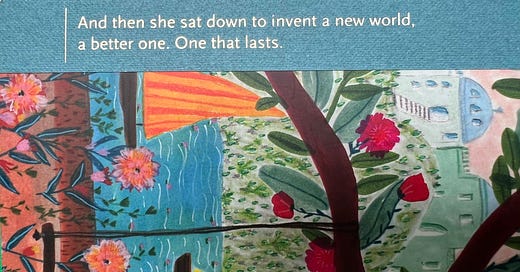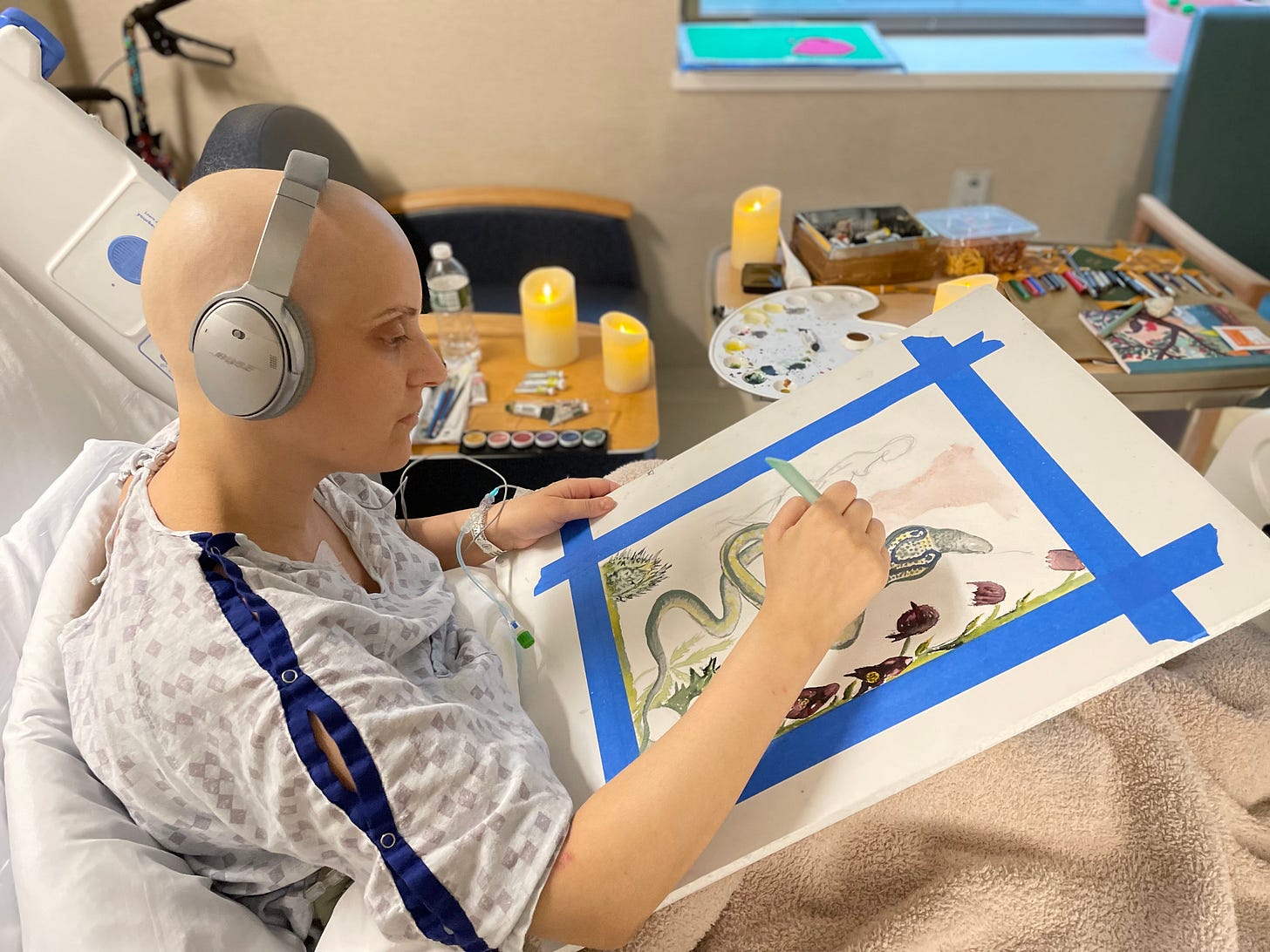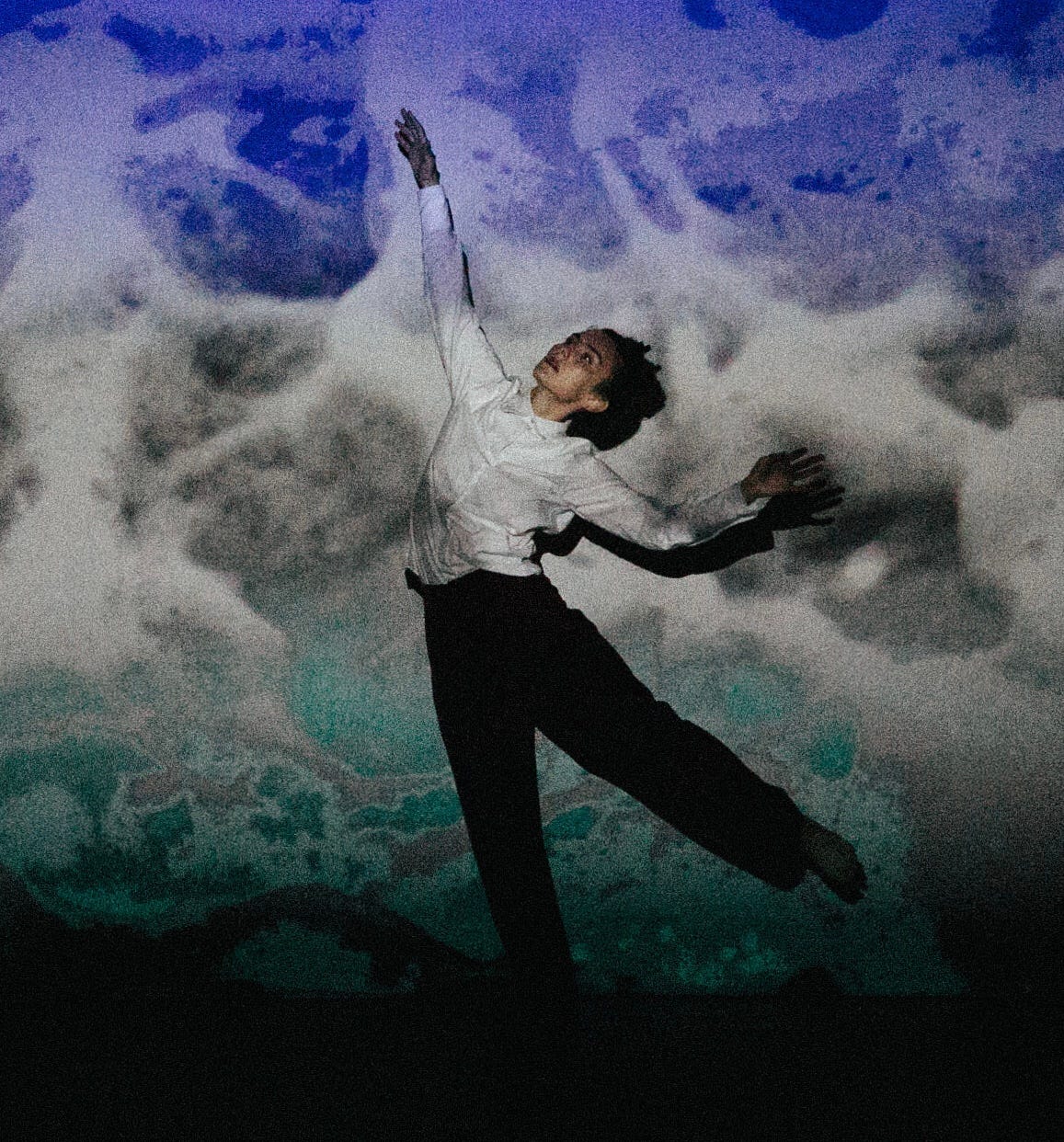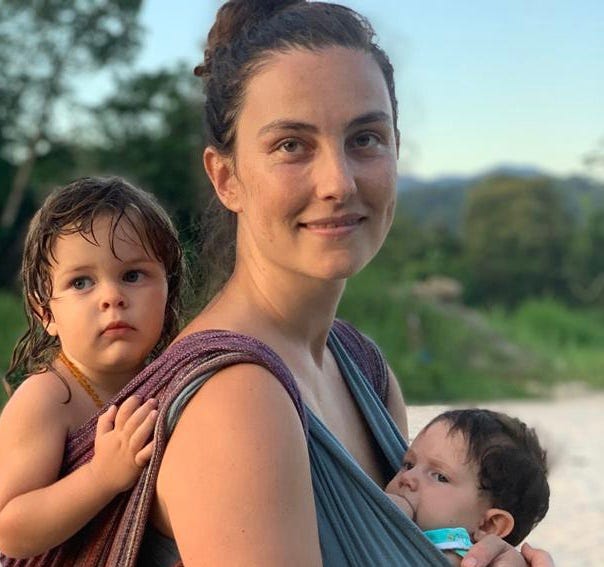Roiling, Coiling, Shapeshifting
& dancer Sofia Tsirakis on a road trip with no fixed destination
Hi friend,
The first ten days of my 100-day project did not look anything like I’d imagined.
I was supposed to get breaks from hospital trips, going only three times a week, and I thought things would be easy and stable. I had tidied up my little painting corner and I’d gotten to work, going bird by bird (literally) on the larger, more ambitious painting that I’d sketched. Then on Monday, I ended up in the ER with a recurrence of bladder cystitis (not a condition I’d recommend to my friends or even my enemies) and graft-versus-host disease, a complication from my transplant. As the hours dragged on and I learned I was going to be readmitted, I realized I wouldn’t be able to paint that day.
So I shifted to a contingency. Carmen was with me, and she went down to the hospital gift shop and found a lovely little notebook, and I spent a few minutes writing. I had seen more than half a dozen doctors and nurses by that point, all of whom had asked me about my symptoms and my pain level, and I had struggled to find words for what I was experiencing. It feels diagnostically important to be intentional with language in situations like this—to be descriptive and accurate. So to wrest back some control, I wrote down all the symptoms I was having. Then I wrote them again, and then again, each time in more vivid and precise language.
The next day, when Carmen came to visit me in the hospital, she brought my diaper caddy full of watercolors and brushes and some good paper, and I started painting, spurred by the words I’d written: roiling, coiling, constricting, heaving. I began painting an iridescent snake, gleaming eggs, and a bulging belly. I spent the next two days with a brush in my hand, in slight amazement as the painting assumed form. Amid physical pain, fear, and the disappointment of yet another setback, it felt like I was being bewitched in the most pleasant of ways.
This experience was such an important reminder for me in these early days of the 100-day project: that life’s interruptions are not an excuse for me not to show up, and that showing up is the work. It’s not the hours spent at the canvas, but continuing to make the effort in whatever way I can, big or small.
Today we have a prompt from my dear friend, the dancer and choreographer Sofia Tsirakis, who is a powerful model of just this kind of practice. I met Sofia in college and was immediately smitten. She was a couple years ahead of me, and I came to think of her as an older sister. We spent a lot of time together the summer after I graduated from college—the summer before my first diagnosis—running around New York City, dancing into the wee hours and getting into all kinds of mischief. On one of her visits to see me in the hospital, I invited her to join me in my first 100-day project. I’ll leave you here, and let her tell you where it led.
Off to paint another fever dream,
Suleika
P.S. I shared my latest painting and a meditation on how to keep showing up for your creative practice when life interrupts. You can read it here and join the discussion about the highs and lows of the first ten days!
The Isolation Journals is my newsletter for people seeking to transform life's interruptions into creative grist. Both free and paid subscriptions are available. The best way to support my work is with a paid subscription, where you get added benefits like access to my advice column Dear Susu, an archive of interviews with amazing artists, behind-the-scenes tidbits from me, our virtual writing hour the Hatch, and other opportunities for creative community.
Prompt 190. One Hundred Small Dances
Almost a decade ago, when dear Suleika was first diagnosed with leukemia and began treatment, she invited me to join her in her first 100-day project. I was inspired by the invitation. I thought of it as a way to stay at Suleika’s side—to be in constant communion—even when we couldn’t see each other. I had a gorgeous new sketchbook, and I decided I would fill one page a day with drawings and writing.
Yet despite my initial enthusiasm, I struggled to make it stick. I had a few false starts, but I couldn’t find a rhythm, and eventually those blank pages began to feel daunting and anxiety-provoking. It didn’t help that I was at a crossroads, both personally and professionally. I had studied philosophy and visual art in college, but I was considering devoting myself to dance—a true love of mine from when I was very young. I was also torn on where to live. New York was appealing, since all my friends from college were there, and I was starting to break into the local dance scene. Yet I missed my home country of Brazil: the humid, tropical climate with its thriving green life, the way the plants, animals, insects manage to dominate even the concrete jungle of São Paulo.
Finally, I made the leap and left New York in the summer of 2012. I planned to spend a few months participating in dance festivals in Europe before moving back home. In the transition, I put aside the 100-day project—though it’s actually more accurate to say that I started a new one. During that trip, I began a new daily habit: I simply moved in whatever way my body wanted in that very instant, and I recorded these short, improvised dances on my phone. It was only sometime later that I realized this was my 100-day project. This was journaling in dance form, helping me navigate these decisions that were so based on my visceral feelings. It was also something I could look back on and see how I was doing day-by-day, how my mood was evolving and changing, and my dancing too.
My small dance practice deepened along an intuitive path. I would close my eyes and focus first on breathing, trying to listen, to let my body guide me. Sometimes I listened to music, but often I did it in silence. I began using a timer, choosing an interval that felt less predictable than five or ten minutes. Instead, I would inhabit this practice continuously until three or maybe nine minutes had passed.
With time, the 100 dances multiplied, the videos accumulated, and to this day there is a folder on my hard drive entitled “1000 dances.” (Initially it was a typo, funnily prophetic.) I think of it as a ritual, one I use to this day in my own personal practice and in teaching and choreography. When explaining this practice to my collaborators and students, I describe it as a road trip with no fixed destination.
Your prompt for the week:
Find a place where you feel comfortable moving around. It can even be sitting or lying down in bed. Close your eyes, breathe deeply, and connect to your body. What does it feel like doing? In which small ways does it want to move?
For six minutes, follow its lead. Move in whatever ways—big or small or ridiculous—that come up. Enter this flux of movement as if you’re on a road trip with no fixed destination, visiting all the spots that spark your interest. If emotional responses like crying or laughing come up, embrace them as part of the dance. Remember: our bodies are in constant flux, so this dance can encompass apparent stillness, or tiny imperceptible movements accompanied by your awareness.
After the six minutes are up, enter a moment of stillness. Then, when you’re ready, write for five minutes about all the secrets that moved inside you.
Optional: Put your phone or laptop in a corner to record on video.
If you’d like some musical inspiration to accompany your movement and writing, Sofia suggests:
For No Apparent Reason by Anouar Brahem
Croquis Et Agaceries Jazz by Andre Balboni
If you’d like, you can post your response in the comments below, in our Facebook group, or on Instagram by tagging @theisolationjournals.
Today’s Contributor
Sofia Tsirakis is a dancer, choreographer, and transdisciplinary artist based in São Paulo, Brazil. As a recent mama of two, she’s currently interested in integrating life education and creative practices.
Featured Community Member of the Week
Brenda Henriques found the Isolation Journals at a critical time: after a cancer diagnosis and treatment caused her to stop making jewelry. Then she joined the 100-day project, and this is what she said: “The challenge of making and posting something every day for 100 days intrigued me and has brought me back into my studio. It inspired me and gave me something bigger to occupy my mind. A problem to solve, which is why I make jewelry.”
The theme of Brenda’s 100-day project is “You can make jewelry out of anything…” She’s using found objects and odd bits that she’s been collecting for 30 years. On the left is Day 5’s Pony Comb, made from a childhood comb and African trade beads. On the right is Day 6’s Sew What?, made with vintage thimbles from the Zettelmeyer Coal Company and the Equitable Life insurance Company, glass tubes, fresh water pearls, and sterling silver.
To learn more about the 100-day project, and find answers to commonly asked questions too, click here.
For more paid subscriber benefits, see—
My latest painting and a meditation on how to keep showing up for your creative practice when life interrupts, plus a community discussion thread
Jon Batiste on The Art of Failure: An Interview & his Ma’s Red Beans & Rice recipe
In honor of National Poetry Month, an interview with Marie Howe: On what the living do









"Life’s interruptions are not an excuse for me not to show up, and that showing up is the work." I love this thought; it resonates deeply with me.
Hello again Dearest Suleika....and Hello Dearest Sofia
Most Sunday mornings, i try to take a Zumba class, (these days virtually), with the gorgeously talented and wonderful Jose Ozuna through the Alvin Ailey Dance Extension in Manhattan. This morning, i was prepared to ignore my alarm and skip my class, due to a sense of, well just needing to rest and let everything pass through me...and then i read your stunningly inspiring prompt this morning.....and i got up, and pushed myself through whatever had been holding me back, and took Jose's exquisite class. With a zillion gratitudes and much much love for you. and holding you in thoughts, prayers and hopes, always!
janet